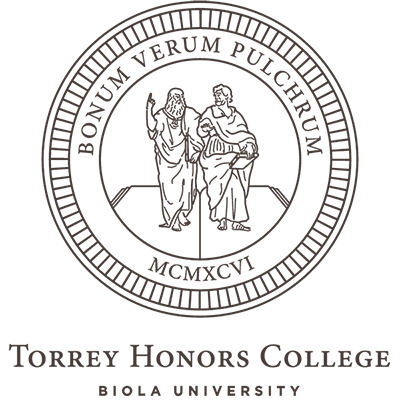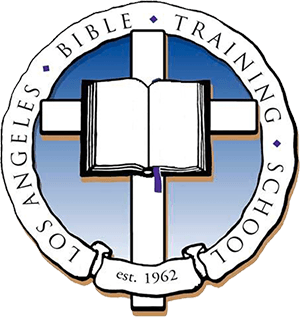A scene from The Canterbury Psalter (12th century)
Blog
Reading a Nativity Image
Let’s look at a nativity image.
Around Christmas, you see birth-of-Christ imagery of all kinds, simplified or elaborated with a variety of details and variations. Things are left out, things are patched in. And even if you search the early centuries of the Christian visual tradition for the first nativity images, you find a lot of variation (magi took an early lead over shepherds, for instance). Nativity images are a kind of placeholder for layers and layers of interpretive meditation. Any particular one you happen to see probably contains selections from a wonderfully expansive tradition of visual interpretation of the meaning of Christ’s birth.
To see the full range of visual interpretation, you could study one of the more cluttered icons from the elaborate Byzantine tradition. But my personal favorite is the extremely bookish and highly verbal tradition known as the Biblia Pauperum. Take a look at the Nativity page of this fifteenth-century Biblia Pauperum:
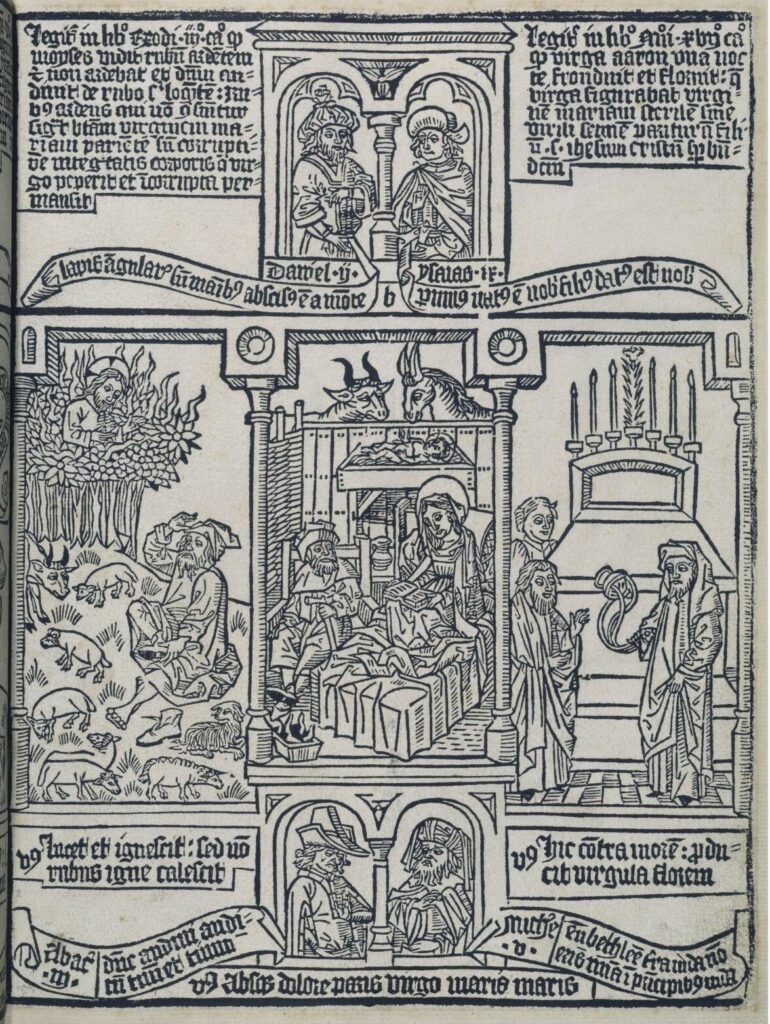
At a glance you can see that it’s not just one picture but at least three: a nativity flanked by two other scenes. And around that are half-portraits of prophets, and about nine zones of text. Let me point out some of what’s going on here. I’m drawing mostly on the research gathered in the wonderful 1987 facsimile edition of this Biblia Pauperum, edited and annotated by Avril Henry.

The central image has Mary propped up in a raised bed, reading. A visually smaller Joseph, lacking a halo, sits beside her in a wooden chair, warming his (geriatric?) feet at the fire. The garments, furniture, and drapery suggest medieval Europe more than first-century Judea.
The linework is simple enough to remind us of a coloring book, but there are plenty of lines doing plenty of work: the fire casts shadows pretty accurately, and the shadow under the manger helps direct visual attention to the baby. More on him in a moment.
The medium the artist is working in is a blockbook: It’s an elaborate form of woodcut that combines words and pictures. When you look at the linework here, remember that the white spaces all had to be carved out away from the raised black lines so the page could be printed from the wooden black all at once like an enormously complex stamp. Blockbooks flourished for less than a century, because the same technological advances in printing that made them possible went further and made them obsolete: movable type presented many more opportunities. But for a brief time, an artist like this one made the most of the blockbook’s possibilities. Look how the corner of the bed moves toward the viewer (linear perspective deftly deployed) and crosses the horizontal line defining the border of the scene itself, swelling subtly in thickness as it goes. Every line really counts in this medium. Also every dot: check out those nails in the wood paneling.
Speaking of the wood paneling, that wooden manger is supported against the wall with solid carpentry, and the livestock are looking in to their once-and-future food trough. The ox seems to be pursing his lips; the ass gritting his teeth.

Depicting the ox and ass, out of all the animals possible at a manger scene, belongs to a tradition that is not made explicit here. The artist is following the rules without articulating them. You may not believe me, but it has to be an ox and an ass because Isaiah 1:3 says
The ox knows its owner,
and the donkey its master’s crib,
but Israel does not know,
my people do not understand.
Already by the second century, Origen of Alexandria (in a sermon on Luke) associated this passage with the Bethlehem “crib” or “manger” (the same word, φάτνη, occurs in the Greek translation of the Isaiah passage as in Luke 2). Ox and ass are animals showing intelligent obedience to their lord, and simultaneously remind us of human foolishness and disobedience.
You may be thinking that’s a lot to read into Isaiah 1:3, but I hope you take my word for it that it’s not too much to read into the Christian iconographic tradition. In fact, there’s even more going on. The Greek version of Habakkuk 3:2 says “in the midst of two animals thou shalt be known.” (ἐν μέσῳ δύο ζῴων γνωσθήσῃ). Working directly from Hebrew, modern translations almost all say “in the midst of the years make it known.” But the associative mind of the early Christian interpreters knew of one possible place where the Lord was made known between two animals (Hab. 3:2) and even knew which two animals they were (Isa. 1:3).
If our artist is thinking of Habakkuk 3:2, he has certainly drawn a striking image of it: that baby is definitely between two animals. Can we prove that Habakkuk is behind this? Not definitively. But one of the four prophecies printed on this page is, believe it or not, Habakkuk 3:2. It’s just not the phrase “between two animals.” Here it is, from the bottom left corner:

Habakkuk, with stylized hat and mannered gesture, has a banderole scrolling away to his left: It says “domine audiui auditionem tuum et timui,” “Lord, I have heard what you said, and am afraid.” And it is tagged,”Abacuc iii,” that is, Habakkuk 3. (I put a little hand beside that part. You have to sort of already know what some of this stuff says to be able to make it out; Henry provides transcriptions as well as translations. By the way, the box above that is a reference to the burning bush; disregard for now.) I won’t insist on this, but I do think the artist puts Habakkuk’s prophecy on this nativity page because he is thinking of the two animals. Furthermore, he may expect you to read the opening words of Hab. 3:2 and autocomplete the part about two animals, which he has drawn for you in the center of the page. There’s a word for this move, when an author cites one part of a passage and expects the audience to be able to call to mind the larger context: it’s called metalepsis. And I do think it’s happening here: “Abacuc iii” means more than just the words quoted. It is orbiting the powerful force of the central image, the nativity.
Speaking of that central image, let’s return to it. It is flanked by two others of equal size:
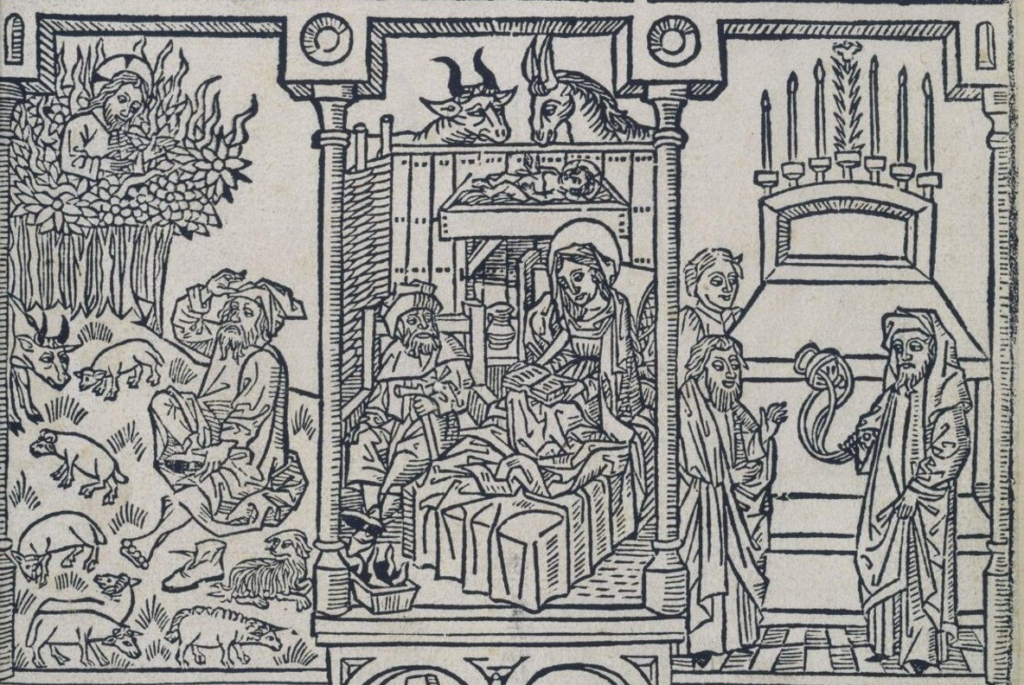
On the left is Moses removing his shoes at the burning bush (Exodus 3), and on the right is the less famous story of Aaron’s rod blossoming (less famous, though the account of it takes up an entire chapter of the Pentateuch, Numbers 17). Both are miracles in which God testifies to himself, making his identity clear directly to Moses on the one hand, and making his selection of Aaron clear to the people of Israel on the other. These sons of Levi will be God’s prophet and priest. By flanking the birth of Christ with these two images, the artist is calling them in as witnesses to Christ as the consummate prophet and priest, the effective word of God that accomplishes the reconciliation it promises. This is the heart of the Biblia Pauperum: typology. Moses and Aaron are historical types; Christ the fulfillment is what we call the antitype, or the thing itself represented by the symbols. They mean him.

And the types signify Christ in pretty sophisticated ways. In the broadest perspective, Moses points to Christ in his entire ministry, by Moses’ being who he was through the entire scope of his life and work. But the artist is invoking Moses here much more specifically, in a visualized scene from Scripture. We are seeing Moses as the one who recognizes that he is in the presence of the uniquely holy reality of God, precisely in the manifestation of God as fire that does not consume the bush in which it burns.
The artist takes advantage of the chance to draw lots of animals: six sheep, a cow/ox, and maybe (?) a long-haired sheepdog (he is the only quadruped here without cloven hooves) who gives Moses’ discalced foot a suspicious side-eye.
But Moses looms largest, and having removed one shoe already (check out his five circle-toes foreshortened right at us!), he pulls the second off with his left hand. With his other hand he shields his eyes or gestures in reverence toward the fiery theophany. It’s not just any theophany; it’s one that is manifested within a creature, the bush. The bush itself, meanwhile, remains completely itself and completely unharmed as the holy fire shines forth from it. This Moses image on the left is a prefiguration of the virgin birth, and Moses models our response.

In this case, we can know the artist’s intention for sure, because the block of text above the image of Moses tells us in some detail: “According to Exodus 3:1-14, Moses saw the burning bush, and it did not burn, and he heard the Lord speaking to him from the bush. The burning bush which is not consumed prefigures the blessed Virgin bearing a child without defilement of her body. A Virgin, she gave birth and remained pure.” Again, it’s worth noting how difficult it is to make out the words of this script; we should not think of this books users or owners as being illiterate. They were likely pretty well trained in how to figure out all that was here to be seen and read.
Speaking of what is to be read, a second short bit of text below the image of Moses provides the commentary: “It glows and kindles but the bush is not consumed by fire.”


Meanwhile, the second typological image is of Moses’ brother, Aaron. We see him here in priestly garments, swinging the censer or thurible at representatives of the people of Israel who objected to his authority. Perhaps he is swinging it in their faces. The explanatory block of text above him says, “According to Numbers 17:1-11, the rod of Aaron burst into leaf and blossom one night. This rod prefigured the Virgin Mary who, unfertilized by male seed, was to bring forth the ever-blessed Jesus Christ.” Once again, the image has been chosen because of the specific meaning of the miracle. Wooden rods don’t blossom. They are cut off from natural modes of production and reproduction; they don’t have it within them to produce blossoms, or (as Aaron’s did) ripened almonds. Likewise the virginal conception and birth of Jesus from Mary. The shorter commentary beneath the image underlines this:

“Versus hic contra morem: producit virgula florem.” Henry translates, “This is against nature: a rod bears a blossom.” I have questions about the virgula/virgin wordplay happening here, and I’m not sure “against nature” is the best way to render “contra morem” without being misunderstood. But especially if you combine this flower-and-fruit imagery with the bush-and-flame imagery on the other side, you get a powerful evocation of the miracle and mystery of God making himself present. (See more on Aaron’s Rod at the Visual Commentary on Scripture exhibition page about it, including an 11th-century example of it being juxtaposed with –the burning bush.) I should also say that the apocryphal medieval stories about Mary’s childhood and betrothal included a legendary tale of Joseph himself engaging in a contest very similar to that of Aaron, and of God causing his wooden staff to bloom. The tale is obviously retconned specifically to rhyme with Aaron’s, but it is likely present to the mind of our artist, who has given Joseph at least a gratuitous walking crutch.
Though the Biblia Pauperum is remarkably text-heavy, we shouldn’t reduce it to propositional argument. Its strategy is obviously to deploy all this textual reasoning in a visual/spatial mode, and this opens up the reader/viewer to make connections that are purely image-based. For example: since Moses and Joseph are side by side in the layout, there’s an implicit dialogue between their figures. I ask you: how is Moses like Joseph? I won’t linger for the answer, but notice that the artist has these two bearded men fiddling with their feet in the presence of flames, while looking away toward the site of the miracle. What’s going on here? The question only arises because panels are tightly juxtaposed in a not-just-textual medium.

In describing what’s happening in this central, typological triptych, I’ve focused so far on the biblical story and the dramatic gestures of the largest figures in each scene. Except for the ox and ass, I’ve skimped on describing what happens in the top portion of each scene. But take a look at them:

Avril Henry points out (p. 51 of her Biblia Pauperum facsimile), “the topmost elements in all the scenes also imply sacrifice.” Perhaps this connection is over-subtle, but I think there’s something to it. Start from Christ, conspicuously laid out on the flat surface of a manger rather than nestled down into it. It’s more altar-like than it needs to be, and this firstborn son is stretched out on the wood there. The visual manifestation of the Lord in the burning bush takes place in fire, and fire is what descends to consume a sacrifice in confirmation of the message and ministry of Elijah. Aaron’s rod is perhaps the least sacrificial, but it happens in a temple space (and the artist situates it in the midst of a menorah-like array of seven staffs, though a straightforward reading of the story seems to call for twelve). Perhaps “sacrificial” is not the right key to what these three images have in common. The reader, or viewer, is invited to ponder this juxtaposed set of icons-within-the-icon. You may discern something other viewers do not detect. And part of the power of the Biblia Pauperum‘s elaborate strategy of juxtaposition is that in the act of meditation, you’ll find yourself meditating not just on the (demonstrable) cleverness of this fifteenth-century woodcut artist, but on the iconographic tradition behind it, and the realities behind that: the figural readings to which you are invited by a God who declares his salvation in mysterious ways.
Finally we come to a special feature of the Biblia Pauperum: four prophets with their abbreviated banderoles (what sufficed for word balloons in the dark days before the invention of comic books). Each prophet gets a portrait, an identifying label, and a prophecy scroll. Here are the two at the top of the page;
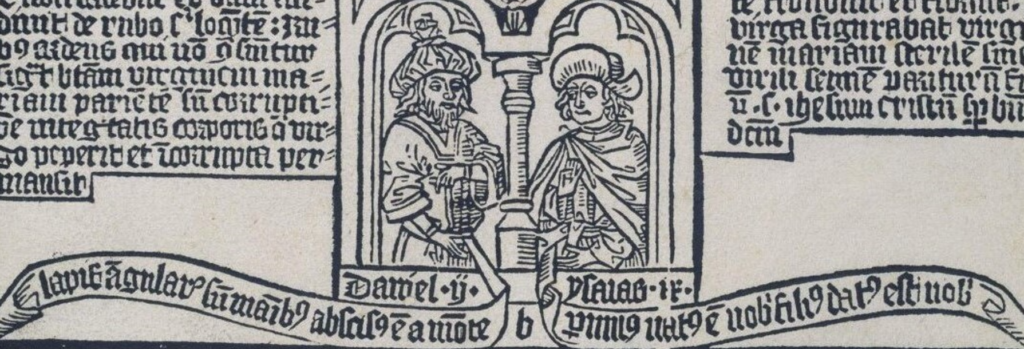

Daniel 2 (verses 34-35) tells us “From the mountain-side was struck a corner-stone no hands had quarried.” And Isaiah 9 (verse 6) says, “to us a child is born, a son is given.” Daniel’s verse is a symbol of the virgin birth: an unquarried cornerstone is like the miraculous conception and birth. Isaiah’s verse is less directly connected to the virgin birth, though Isaiah 9 is just a couple of chapters away from Isaiah’s 7 “a virgin will conceive” sign. Metalepsis again: let the brief passage remind you of the full context. Isaiah’s figure is also positioned directly above baby Jesus on the page, so it’s possible his “son is given” passage indicates not so much the virginality of the birth, but the gift of the Son of God as the son of Mary.
At the bottom of the page, our two prophets are Habbakuk (already discussed) and Micah 2 (verse 6): “Bethlehem of the land of Judah, you are not least among the princes of Juda.” Micah’s words, like those of Isaiah directly above him, are less about the virgin birth and more about the overall nativity as a fulfillment of prophecy. The agreement of Isaiah and Micah along this tall vertical axis raises the question of whether the entire page might be split down the middle , with the symbols of the right-hand side focused on one set of associations (more generally prophetic, with a broader purview taking in Bethlehem as the site of fulfilled prophecy), and the left on another (more specifically about the virgin birth).

Finally, a foundational text at the very base of the page: “O Virgin Mary, you bear a child without the pain caused by man.” It’s commentary rather than Scripture, but it keys you in to the central idea around which the artist has arranged the elements of the page.
This page emphasizes the theology of “the virgin birth,” in the strictest sense: not the miraculous virginal conception, but the actual birth of Jesus. Recall that the creed confesses both moments: “he was conceived by the Holy Spirit, born of the virgin Mary.” The virginal conception (in some ways the real, foundational miracle) was nine months prior, and it is usually visualized as the annunciation. The Biblia Pauperum we’ve been reading consists of 40 images, facing each other in pairs. This nativity image is the second in the volume, but it faces the first, which is: the annunciation. Here’s a blurry, low-res, and colorized version just to show you how they are laid out:

Often we legitimately bundle together conception and birth as part of a single complex miracle of the incarnation. In one sense, the Biblia Pauperum also bundles them, but it does so by once again using its favored mode: juxtaposition. On the left is conception, on the right nativity. Read them together and let them converse. But by also distinguishing them, our artist opens up even more space to ponder. Mary in particular emerges not so much as the one who hears and believes the word of the Lord (that’s an annunciation theme), but as the one who is the unharmed, unburned, undestroyed human source and origin of the incarnate word.
There’s plenty more to say about the nativity page in the Biblia Pauperum. I’ve skipped over the ways in which it includes aspects of the belief in Mary’s perpetual virginity, and especially the theologoumenon that claims she was miraculously unharmed by the very act of giving birth, bringing forth a full-term child without pain or exertion. I have no doubt our artist affirmed that idea, or that the imagery and proof texts he is employing had long been intentionally collated by the tradition with that as a further claim. Even if I believed the virginity of Mary to be perpetual in this sense, I would consider it a claim of a much lower order than the main point of the nativity. And for all the complexity in which it luxuriates, this Biblia Pauperum manages to keep the main thing the main thing; for all its alertness to Mariology, it is primarily a Christological image. And that’s good theology.
I’ve used a very sharp, uncolored image ,but here’s a much less legible version of the page with some judicious use of two or three colors.

About This Blog

Fred Sanders is a theologian who tried to specialize in the doctrine of the Trinity, but found that everything in Christian life and thought is connected to the triune God.
